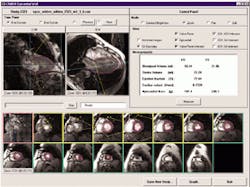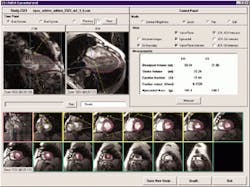MRI software analyzes heart functions
Magnetic resonance imaging (MRI) is a noninvasive method for diagnosis and management of patients with cardiovascular disease. Although there are approximately 8000 MRI scanners in use worldwide, very few medical centers perform MRI analysis due to the lack of affordable software capable of processing spatial and time (four-dimensional) data. Currently available software packages tend to use proprietary image formats and run on Unix workstations.
To perform such analysis automatically, the Edinburgh Parallel Computing Centre (EPCC; Edinburgh, Scotland) has developed a free software package that provides doctors with detailed information and quantitative measurements about how the heart is functioning. Dubbed cardiac magnetic resonance image analysis (CAMRA), the software has undergone trials at several hospitals in Europe, including Addenbrooke's Hospital (Cambridge, England).
CAMRA supports both manual and automatic segmentation. The latter technique uses an active-contour-model-based technique, together with facilities to allow contour review and modification.
Says Martin Graves, a clinical scientist at Addenbrooke's Hospital, "CAMRA is the first solution for the quantitative analysis of cardiac MRI images. Comparative studies have shown excellent agreement between CAMRA and manual analysis methods." Downloadable from the Web at www.epcc.ed. ac.uk/ ttn/CAMRA, the software is designed to provide a reproducible analysis of the left ventricular function from MRI scans of the heart.
CAMRA improves the productivity of cardiovascular MRI studies by providing a multithreaded, scalable system working on a single or multiprocessor PCs running Windows NT. Using the Digital Imaging and Communications in Medicine (DICOM) standard to import images over Ethernet via TCP/IP, the software can be used with scanners from different vendors. Recently, the software has been tested with data from MRI scanners from GE Genesis Signa 1.5 T, Siemens Magnetom Vision, and Philips Gyroscan.
CAMRA supports both manual and automatic segmentation. Automatic segmentation uses an active-contour-model technique that permits contour review and modification. "CAMRA produces four-dimensional images (3-D plus time) with time intervals charted to show a progression of heart movements that depict how the heart is functioning," says Graves. For example, segmentation of the endocardial border on a data set can now be performed in less time than the current manual practice that typically segments only 8% of the data.

